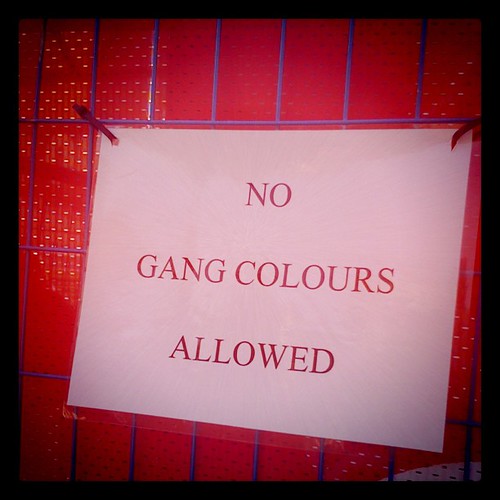Why do the best need a handicap to show they’re the best?
.The original title of this post was going to be “Why do gangs wear gang colors?” which is the question the study abstract below addresses. However I think it leads us to some much more interesting ideas. Anyway, let’s start in the world of Crips and Bloods:
Criminals who wear gang colors are acting in a surprisingly brazen way which must increase the probability of being caught and punished by the police. In our model this brazen behavior is a solution to an enforcement problem. The central idea is that less able criminals see lower gains from continued participation in crime because they will be caught and punished more often. Lower future gains imply that reputational concerns will be less effective at enforcing honesty. Only dealing with brazen criminals will become a good way to avoid dealing with incompetent criminals, because they cannot afford to mimic the brazen behavior. The principle is similar to the selection for a handicap in evolutionary biology.
Source: “Are “Gangstas” Peacocks? The Handicap Principle and Illicit Markets” from University of Oxford, Department of Economics, Working Papers #558.
That’s a little heavy on the mumbo-jumbo. Let’s make it accessible because the underlying theory is quite interesting and we see it everywhere. So what’s this “handicap principle” they refer to in the final sentence?
The Handicap Principle proves you’re very good at something via a handicap that you are clearly able to overcome.
Can you win a race while holding a 50lb dumbbell? Then you must be fast.
Can you fight the best boxers in the world holding your hands down at your sides instead of protecting your face? Then you must be the greatest:
How does this relate to the paper?
Diego Gambetta explains in his excellent book Codes of the Underworld: How Criminals Communicate that “signalling” is extremely important for criminals. How can I trust what you say if, to be a good criminal, you are, almost by definition, untrustworthy? Words don’t cut it because people will lie. Criminals need signals that are more “costly.” Scars, tattoos, years in prison… signals that are very difficult to fake.
The paper is saying that the gang color issue uses the handicap principle to address the criminal signalling question “How can I tell if you’re good at what you do in an arena where there are no reliable résumés?” And the answer is: If you can wear something that clearly identifies you as a gang member to law enforcement and yet you’re still walking the streets, you must be very good at being a criminal.
Wikipedia does an okay job of explaining the handicap principle. You know who does a better job? Gary Oldman (from a script by Quentin Tarantino.) Watch the first two minutes of this clip from True Romance (very NSFW) for a more accessible explanation of the handicap principle:
Did I mention I blog with one hand tied behind my back? Yeah. I’m that good.
Join 25K+ readers. Get a free weekly update via email here.
Related posts:
What 10 things should you do every day to improve your life?
What do people regret the most before they die?
What five things can make sure you never stop growing and learning?





